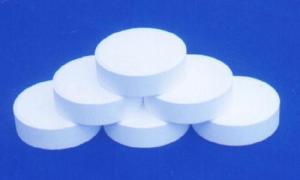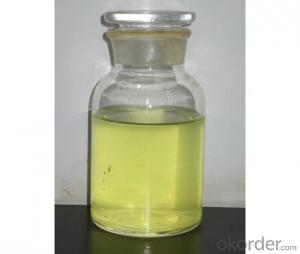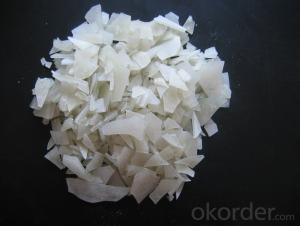Sodium Hypochlorite Plant Quality China Supplier
- Loading Port:
- Tianjin
- Payment Terms:
- TT OR LC
- Min Order Qty:
- 25 m.t.
- Supply Capability:
- 6000 m.t./month
OKorder Service Pledge
OKorder Financial Service
You Might Also Like
Sodium Hypochlorite
CAS NO: 7681-52-9
Chemical Formula: NaClO
Molecular Weight: 74.44
Appearance: Yellow transparent Liquid
Standard: HG/T2498-1993
Specification:
Available Chlorine: 8%-16%
NaOH: 1% Max
Transportation Info:
Class: 8 UN NO: 1791 PG:III
Application:
Disinfection for swimming pool, drinking water, cooling tower and sewage and waste water, food, and farming, hospital, school, station and household etc
Good bleaching and oxidation in paper and dye industry.

Normal Packing: 30kg drum, 1200kg IBC Tank
| Calcium Hypochlorite | ||
SYNONYMS: | Bleaching powder, Hypochlorous Acid, Calcium Salt; Losantin; Calcium Hypochloride; Chlorinated lime. | ||
FORMULA: | Ca(clo)2 | ||
MOLECULAR WEIGHT: | 142.98 | ||
PROPERTIES: | Appearance white or light-grey power,granule, mixed,tablet | ||
EINECS NO: | 231-908-7 | ||
CAS NO.: | 7778-54-3 | ||
Hazard Class: | 5.1 | ||
UN No.: | 1748 | ||
H.S. CODE: | 2828 1000 | ||
SPECIFICATIONS: | Components: | Guaranteed Analysis | Typical Analysis: |
Available Chlorine: | 65%min | 65.2% | |
Moisture: | 3%max | 2.5% | |
Yearly Loss of Chlorine: | 8% | 8% | |
Calcium Chloride : | 9% | 9% | |
PACKAGING: | Normally in plastic or steel drums lined with inner per bag of 45-50kg II class net each .Can be adaptable in terms of various requirements. | ||
QUANTITY PER CONTAINER: | 20MTS/20’FCL(NON-PALLETIZED) for ocean shipping; | ||
HANDLING & STORAGE: | 1)Should be stored in cool and dry warehouse away from heating sources and avoid direct sunlight. 2) In transportation, contact with such should be avoided as sunlight, heating, moisture, organics, oil and acids. How to handle in case of leakage: Collect in time and seal properly. | ||
RECOMMENDED | 1. For bleaching purpose of wood pulp, silk, cloth and fibre. | ||
- Q: Have you Read it ? If SoCan You Think Of Any Good Group Discussion Questions ?
- no but aOMG i laurie halse anderson! OMG I LOVED HER BOOK FEVER 1793 wooooooooooo that book was aweomse. you should read it
- Q: Can a catalyst decrease the rate of a chemical reaction? Please give an example if yes.
- A catalyst is something that quickens the fee of reaction without getting used up itself. They many times try this by skill of lowering the activation skill, which additionally brings the optimal temperature down. So, to place it only, it relatively is B.
- Q: The chemical equation of heating reaction of benzene and hydrogen under the action of catalyst
- C6H6 benzene + 3H2 - (arrow) C6H12 cyclohexane (Ni catalytic heating)
- Q: Pls help me define a catalyst.?
- catalyst is a substance which increases or decreases the rate of recation without being involve in the reaction
- Q: The properties of scandium
- Sci-Scandium (Sc) Basic knowledge Introduction In 1879, Swedish chemistry professor Nelson (LFNilson, 1840 ~ 1899) and Clive (PTCleve, 1840 ~ 1905) were almost simultaneously in rare mineral silica beryllium yttrium and black The mine found a new element. They named this element "Scandium" (scandium), ...
- Q: And hydrogen peroxide
- Yes, as long as it is copper ions and iron ions on the line, such as FeCI can
- Q: The greater the chemical adsorption strength, the catalyst activity changes
- If the adsorbent is a reactant, then the better the adsorption capacity of the better catalytic effect; but the catalyst surface of the product will generally have adsorption, if this effect has become very strong, then desorption The process will become difficult, the catalytic effect will decline; the other one, if the adsorption of other substances, such as the reaction may produce a reaction or the catalyst will poison the material, it is greatly detrimental to the catalytic effect. The effect is to be controlled in a suitable optimum range for superior, and preferably to be selectively adsorbed.
- Q: Why does the chemical and chemical properties change before and after the reaction?
- Catalysts are homogeneous catalysts with heterogeneous catalysts. The heterogeneous catalyst exhibits a reaction in a different phase (e.g., a solid catalyst in a liquid mixing reaction) and a homogeneous catalyst is a reaction in the same phase (for example, a liquid catalyst in a liquid mixing reaction). A simple heterogeneous catalytic reaction involves the addition of a reactant (or en-ch: substrate; zh-tw: subject) adsorbed on the surface of the catalyst, and the bond within the reactant causes a new bond due to the fragility of the bond, But because of the product and the catalyst between
- Q: hey people i need your help about my science lab report...the question on my paper says "what function the catalyst?....please help me on this one...i would really appreciate if you leave me answers....much mahalos to all you folkss...thanks
- concepts-blowing on Bandit - it converts Carbon monoxide into Carbon Dioxide (besides as emitting risky debris of Platinum, Iridium and tungsten). hang on - Carbon Dioxide - isn't that the ever so nasty greenhouse gas that we are all meant to be reducing our output of? i'm taking my cats off.
Send your message to us
Sodium Hypochlorite Plant Quality China Supplier
- Loading Port:
- Tianjin
- Payment Terms:
- TT OR LC
- Min Order Qty:
- 25 m.t.
- Supply Capability:
- 6000 m.t./month
OKorder Service Pledge
OKorder Financial Service
Similar products
Hot products
Hot Searches
Related keywords





























